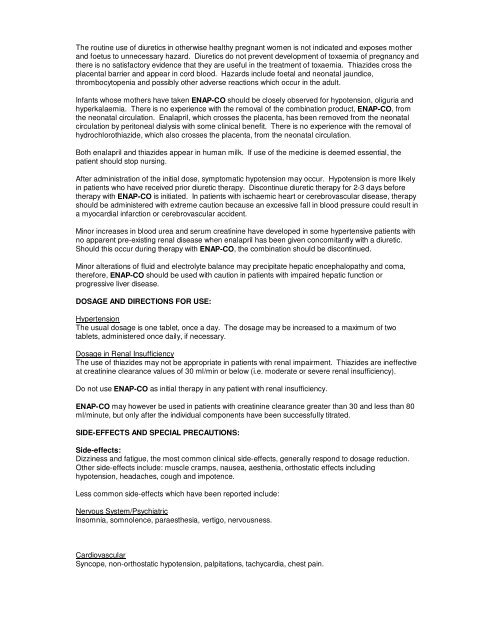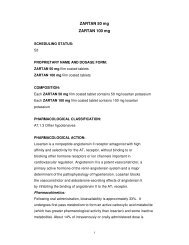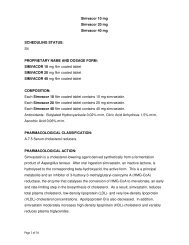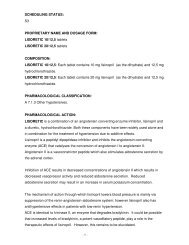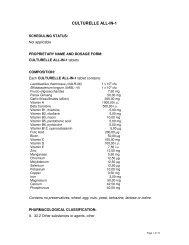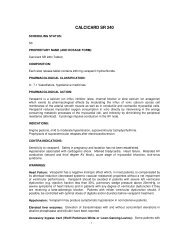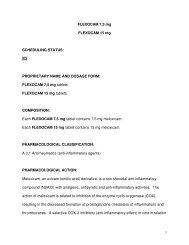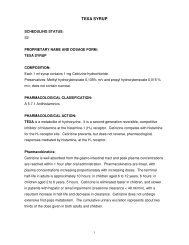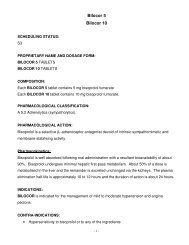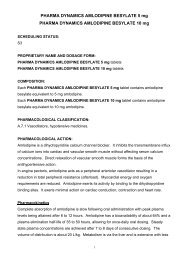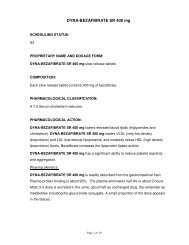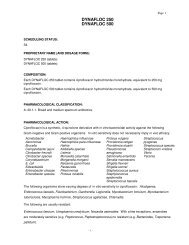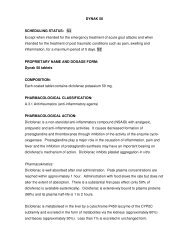ENAP-CO Tablets COMPOSITION - Pharma Dynamics
ENAP-CO Tablets COMPOSITION - Pharma Dynamics
ENAP-CO Tablets COMPOSITION - Pharma Dynamics
Create successful ePaper yourself
Turn your PDF publications into a flip-book with our unique Google optimized e-Paper software.
The routine use of diuretics in otherwise healthy pregnant women is not indicated and exposes mother<br />
and foetus to unnecessary hazard. Diuretics do not prevent development of toxaemia of pregnancy and<br />
there is no satisfactory evidence that they are useful in the treatment of toxaemia. Thiazides cross the<br />
placental barrier and appear in cord blood. Hazards include foetal and neonatal jaundice,<br />
thrombocytopenia and possibly other adverse reactions which occur in the adult.<br />
Infants whose mothers have taken <strong>ENAP</strong>-<strong>CO</strong> should be closely observed for hypotension, oliguria and<br />
hyperkalaemia. There is no experience with the removal of the combination product, <strong>ENAP</strong>-<strong>CO</strong>, from<br />
the neonatal circulation. Enalapril, which crosses the placenta, has been removed from the neonatal<br />
circulation by peritoneal dialysis with some clinical benefit. There is no experience with the removal of<br />
hydrochlorothiazide, which also crosses the placenta, from the neonatal circulation.<br />
Both enalapril and thiazides appear in human milk. If use of the medicine is deemed essential, the<br />
patient should stop nursing.<br />
After administration of the initial dose, symptomatic hypotension may occur. Hypotension is more likely<br />
in patients who have received prior diuretic therapy. Discontinue diuretic therapy for 2-3 days before<br />
therapy with <strong>ENAP</strong>-<strong>CO</strong> is initiated. In patients with ischaemic heart or cerebrovascular disease, therapy<br />
should be administered with extreme caution because an excessive fall in blood pressure could result in<br />
a myocardial infarction or cerebrovascular accident.<br />
Minor increases in blood urea and serum creatinine have developed in some hypertensive patients with<br />
no apparent pre-existing renal disease when enalapril has been given concomitantly with a diuretic.<br />
Should this occur during therapy with <strong>ENAP</strong>-<strong>CO</strong>, the combination should be discontinued.<br />
Minor alterations of fluid and electrolyte balance may precipitate hepatic encephalopathy and coma,<br />
therefore, <strong>ENAP</strong>-<strong>CO</strong> should be used with caution in patients with impaired hepatic function or<br />
progressive liver disease.<br />
DOSAGE AND DIRECTIONS FOR USE:<br />
Hypertension<br />
The usual dosage is one tablet, once a day. The dosage may be increased to a maximum of two<br />
tablets, administered once daily, if necessary.<br />
Dosage in Renal Insufficiency<br />
The use of thiazides may not be appropriate in patients with renal impairment. Thiazides are ineffective<br />
at creatinine clearance values of 30 ml/min or below (i.e. moderate or severe renal insufficiency).<br />
Do not use <strong>ENAP</strong>-<strong>CO</strong> as initial therapy in any patient with renal insufficiency.<br />
<strong>ENAP</strong>-<strong>CO</strong> may however be used in patients with creatinine clearance greater than 30 and less than 80<br />
ml/minute, but only after the individual components have been successfully titrated.<br />
SIDE-EFFECTS AND SPECIAL PRECAUTIONS:<br />
Side-effects:<br />
Dizziness and fatigue, the most common clinical side-effects, generally respond to dosage reduction.<br />
Other side-effects include: muscle cramps, nausea, aesthenia, orthostatic effects including<br />
hypotension, headaches, cough and impotence.<br />
Less common side-effects which have been reported include:<br />
Nervous System/Psychiatric<br />
Insomnia, somnolence, paraesthesia, vertigo, nervousness.<br />
Cardiovascular<br />
Syncope, non-orthostatic hypotension, palpitations, tachycardia, chest pain.


